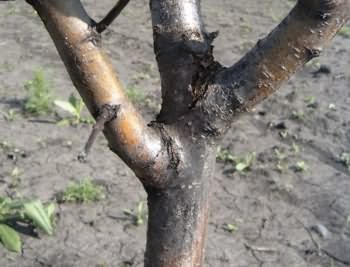Diseases
Sphaeropsis malorum Peck. - Black Rot of Apple
Systematic position.
Sphaeropsis malorum Peck. (anamorph) belongs to division Deuteromycota, class Coelomycetes, order Sphaeropsidales and family Sphaeropsidaceae. Botryosphaeria obtusa (Shwein.) Shoemaker (teleomorph) belongs to division Ascomycota, class Ascomycetes, subclass Dothideomycetide, order Dothideales, family Botryosphaeraceae (James & Hawksworth, 1971).Biological group.
This species is a biotroph.Morphology and biology.
The following three forms of the Black Rot can occur: fruit rot, leaf spot known as frogeye leaf spot, and limb canker of apple. Leaf symptoms first occur in early spring when the leaves are unfolding. They appear as small purple specks on the upper surface of leaves, enlarging into circular lesions 3-6 mm in diameter. The margin of the lesions remains purple, while the center turns tan to brown. In a few weeks a secondary enlargement of these leaf spots occurs. At this time, the lesions assume a characteristic "frog-eye" appearance. As they age, a series of concentric rings develop around the original infection point. Occasionally, small black pycnidia (asexual fungal fruiting body) can be found in the center of the lesion. Lesions resulting in canker formation are usually associated with a wound in the bark. In their early stages the bark is slightly sunken and reddish-brown in color. Some cankers remain small and can die out by the end of the year, while the others enlarge from year to year. Some cankers are observed to be merely a surface roughening of the bark. In other cases, the canker can kill the bark down to the wood, and the area becomes cracked. By the end of the second year, fruiting bodies of the fungus can be observed in the cankered area. Limbs can be completely girdled by this time. The Black Rot fungus is often found on wood previously killed by fire blight or damaged as a result of cold temperatures. The fungus over-winters in ascomata in cankers, especially in those initiated by fire blight, in dead bark, and in mummified fruit. These over-wintering structures provide an important source of the disease inoculum. In spring, ascospores are released during rainfall. Conidia are oblong, straight, aseptate, broadly rounded at apex, truncate at base, with brown wall and ornamented internally, 16.18.26.27 x 9.15.0 microns, produced during wet periods throughout the summer. Ascospores (23.26.34.38 x 7.13 microns, hyaline, aseptate) are primarily airborne, most common during abscission of petals.Distribution.
Areas of the Black Rot epiphytotic development (one time in 2 years, with an incidence of 50-100%) include Georgia, Uzbekistan, Azerbaijan, Moldova, Kherson, Donetsk, and Lugansk Regions of Ukraine. Areas with moderate development of the Black Rot (one time in 3 years, with an incidence of 30-50%) are Adygea, Lithuania, Armenia. To a lesser degree (1 time in 5 years, infection 10-30%) the disease develops in all areas of Ciscaucasia.Ecology.
Heavy and long rainfalls, as well as temperature, are the main factors influencing ascospore release and germination, and infection by the Black Rot. Optimum temperature for germination of ascospores and conidia is 16-27.C, maximum is 32.C.Economic significance.
The Black Rot has an economic significance. Infected fruits become unmarketable; severe leaf spotting can result in defoliation which weakens the tree, and limb cankers can girdle and eventually kill entire branches. Control measures are various, including the use of resistant cultivars, sanitation of orchards, and chemical control.Reference citations:
Barsukova O.N. 1969. Lesion of black rot in apple fruit. Works of V Conference All-Union of Plant Immunity. Kiev: VASHNIL USHA. Issue 14. 54-58 p. (In Russian)Barsukova O.N. 1973. Distribution and harmfulness of Black Rot in apple. In: Brezhnev D.D., ed. Works of applied botany, genetics and selection (Leningrad: VASHNIL VNIIP) 50(2): 142-146 p. (In Russian)
Barsukova O.N. 1977. Black Rot of apple. Dawns of Country. V. 7. Krasnodar: Soviet Kuban. 59-60 p. (In Russian)
Ekimova K.I. 1971. Black Rot of apple in Donbass. In: Popov C.P., ed. Release of conference for teachers and specialists of agricultural. Petrozavodsk: Ministry of higher and specialized secondary education RSFSR PGU. 92-96 p. (In Russian)
James P.W., Hawksworth D.L. 1971. Ainsworth & Bisby.s dictionary of the fungi. 6th edition. CAB: Kew. 663 p.
Khokhraykov M.N., Dobrozrakova T.L., Stepanov K.M., Letova M.F. 2003. Keys to plant diseases. Saint Petersburg: Lan'. 592 p. (In Russian)
Myalova L.A. 1969. Black Rot of apple in Lower Dnepr Region. Khar'kov: Ministry of agricultural USSR HSHI. 21 p. (In Russian)
Oganyan E.A., Mkrtchyan G.G. 1963. Black Rot of apple in north areas of Armenian USR. In: Tovmasyan M.A., ed. Collection of scientific works. Erevan: Ministry of manufacture and storage agricultural produce Armenia USR, Armenian Agricultural Institute. 286-295 p. (In Russian)
Paterilo G.A. 1975. Black Rot of apple in intensive gardens. Gardening, winegrowing and winemaking in Moldavia. V. 7. Kishinev: TsK KP Moldavia. 39-40 p. (In Russian)
Pyshina Z.S. 1978. Black Rot. Zashchita rastenii 11: 52. (In Russian)
Smol.yakova V.M. 2000. Fungal diseases of fruit trees in South Russia. Krasnodar: Vest.. 192 p. (In Russian)
Tsupkova N.A. 1976. Black Rot. Zashchita rastenii 5: 63. (In Russian)


